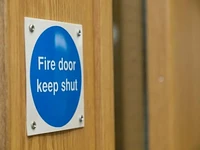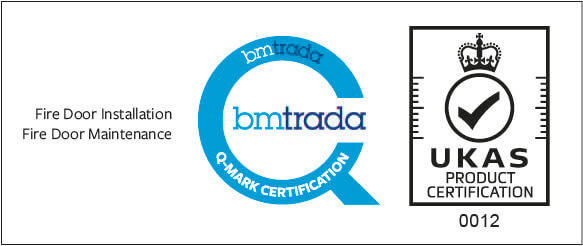Play it Safe: Fire Safety in Tall Buildings
Tall buildings present fire safety issues that don’t affect other structures. For instance, high structures are beyond the reach of ladders preventing exterior rescues from ladders and the suppression of fires with outside hose streams which means they are equipped with more fire safety features.
.webp)
In regards to fire safety, the performance history of very tall buildings while very successful, has not been without catastrophic incidents. Many of these incidents have resulted in numerous deaths and injuries, excessive property loss and disruptions in business continuity.
There are many systems that must be in place to protect tall buildings from the spread of fire and smoke. Passive Fire Protection plays an important role in providing fire safety protection in tall buildings as it does in any other building. A large part of this is fire doors; it's vital they are installed and maintained as fit for purpose.
Your Legal Responsibility
Any person, company or organisation that owns, manages or operates buildings must comply with the Regulatory Reform (Fire Safety) Order 2005. This means that the ‘Responsible Person’ must ensure that a suitable and sufficient fire risk assessment has been carried out and that this includes fire doors and escape doors.
Article 17 of the order includes the duty to engage ‘Competent Persons’ (as referenced in Article 18) as necessary to assist with fire safety measures which of-course includes fire doors.
Furthermore, under clause 5.3 and 5.4 anyone procuring or responsible for installing a fire safety system must ensure that those installing it are up to the job. The first thing to check to ensure a company is ‘up to the job’ is to confirm the company has third party accreditation. Accreditation to carry out the tasks required coupled with industry experience in your sector (such as housing sector, tall buildings, healthcare, education…) will ensure the work carried out will provide the protection you and your visitors need.
The Importance of Fire Doors
Fire doors are an essential part of a building’s passive fire safety strategy. In a fire they provide compartmentation to prevent fire and smoke spread, assisting in safe evacuation and providing protection to the rest of the building.
Essentially, they help to keep a fire in the part of the building where it started and help prevent its development to other parts of the building.
Fire doors are tested and rated for fire separation performance in terms of the time elapsed before the ultimate failure of the door and the most common ratings as referenced in UK Building Regulations are FD30 and FD60 (although higher-rated doors such as FD90 and FD120 are available for use where additional protection is required).
Think of a fire door as an engineered fire safety device that must be installed on-site to replicate what was tested in the fire performance test or you can’t be sure that the door will provide the required level of protection. Many fire doors these days must have any apertures cut and the glazing system fitted only at the manufacturers own factory or by a licensed door processor. On-site cutting of apertures and glazing is not permitted and will invalidate the fire performance certification.
.webp)
Existing Doors
Of course in many buildings, you will be dealing with existing doors rather than new and it will be necessary to inspect and maintain them to ensure they are fit for purpose. This is where it is important that the maintenance team or the contractor has the necessary competence.With existing doors there may be no product certification and maintenance instructions so how can you be sure the repair work you do is correct and that the doors are fit for purpose?
The answer is to make sure that the work is carried out or overseen by qualified people who have fire door qualifications and credentials. Qualified fire door inspectors, repairers and maintainers will be aware of the British and European standards relating to fire doors and their installation as well as publications and best practice guidelines.
Too many times ‘repairs’ such as holes and voids covered with push plates and signs are clearly not acceptable! Suitable fire-rated components must always be used and sufficient intumescent protection must be maintained. A competent repair will not compromise the fire separation properties of the door if carried out by a certified fire professional. Sometimes it’s not possible to repair a fire door because damage to its integrity is so severe or the fire performance certification may limit the scope for repairs and alterations. The door’s fire performance data sheet must be consulted before attempting repairs otherwise this certification may be void.
Fire safety legislation makes it clear that fire doors are installed and maintained as fit for purpose and BS9999 gives guidance about inspections and how often they should be made so it’s an area where you cannot afford to take chances.
How often should my fire doors by inspected?
According to BS 9999, the code of practice for fire safety in the design, management and use of buildings, fire doors should be inspected every six months; however, when asked how often they thought fire doors should be checked, only 40% of respondents were correct.
Almost a third of people surveyed believe fire doors should be inspected once per year, and surprisingly the remaining 30% think they should only be checked as part of a Fire Risk Assessment.
The survey also revealed that 24% of people are unaware that most regular fire doors give occupants just 30 minutes before they lose their integrity and smoke and gases could start to penetrate, with most respondents believing it is one hour.
keeping fire doors in working order both internally and externally is essential. Not only does it help ensure you and your building remain compliant, but it also reduces maintenance costs by catching defects early before a door needs replacing.
Smoke Control
Controlling the spread of smoke is more complicated in tall buildings. For example, tall buildings experience a phenomenon called stack effect. Stack effect occurs when a tall building experiences a pressure difference throughout its height as a result of temperature differentials between the outside air temperature and the inside building temperature. This causes air to move vertically, depending on the outside air temperature – either upward or downward in a building. It can also cause smoke from a building fire to spread throughout the building if not controlled. That is why tall buildings often employ smoke management systems that either vent, exhaust or limit the spread of smoke.
Because very tall buildings complicate smoke spread, effective smoke control is more difficult to achieve. The possible solutions are numerous and include a combination of active and passive features such as but not limited to: 1) smoke barrier walls and floors, 2) stairway pressurization systems, 3) pressurized zoned smoke control provided by the air-handling equipment, and 4) smoke dampers. The solution implemented into the design needs to address the building itself, its uses, relevant occupant characteristics and reliability.
Take Action
If you are responsible for your building, whether tall or not, ensure your passive fire measures as well as your active measures are up to the job and will pass a survey, protect life and protect your building’s integrity. Will your fire doors pass an inspection? Don’t despair, if in doubt contact Checkmate Fire today to ensure your build receives the third party accredited Checkmate Fire approval. Checkmate Fire, among a range of passive fire protection services, carry out fire door surveys, repairs and installation – all accredited under BRE/LPCB scheme LPS 1271 and LPS 1197.





















